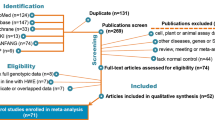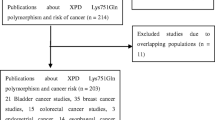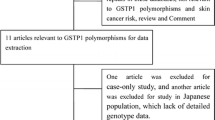Abstract
Single-nucleotide polymorphism of CLPTM1L-rs401681(C > T) at the 5p15.33 locus is significantly associated with cancer risk as reported in genome-wide association studies, but the reported studies for non-melanoma skin cancer (NMSC) are inconclusive. To assess the association between rs401681[C] allele and NMSC risk, we performed this meta-analysis with four case–control studies involving 5,469 cases and 39,715 controls. Our meta-analysis showed that rs401681[C] allele was associated with NMSC susceptibility in the overall subjects (C vs. T, OR 1.13, 95 % CI 1.07–1.20). In the stratified analysis, the rs401681[C] allele confers susceptibility in Icelanders (C vs. T, OR 1.15, 95 % CI 1.06–1.26) and non-Icelanders (C vs. T, OR 1.13, 95 % CI 1.03–1.24). In the subtype analysis, we found that rs401681[C] allele was a risk factor for BCC, but not SCC in the overall subjects.

Similar content being viewed by others
References
Azuma Y, Matsukawa A (1993) Warty dyskeratoma with multiple lesions. J Dermatol 20:374–377
Baird DM (2010) Variation at the TERT locus and predisposition for cancer. Expert Rev Mol Med 12:e16
Choi JE, Kang HG, Jang JS, Choi YY, Kim MJ, Kim JS, Jeon HS, Lee WK, Cha SI, Kim CH, Kam S, Jung TH, Park JY (2009) Polymorphisms in telomere maintenance genes and risk of lung cancer. Cancer Epidem Biomar 18:2773–2781
Chong L, van Steensel B, Broccoli D, Erdjument-Bromage H, Hanish J, Tempst P, de Lange T (1995) A human telomeric protein. Science 270:1663–1667
Gilchrest BA, Eller MS, Geller AC, Yaar M (1999) The pathogenesis of melanoma induced by ultraviolet radiation. New Engl J Med 340:1341–1348
Han J, Qureshi AA, Prescott J, Guo Q, Ye L, Hunter DJ, De Vivo I (2009) A prospective study of telomere length and the risk of skin cancer. J Invest Dermatol 129:415–421
Harle-Bachor C, Boukamp P (1996) Telomerase activity in the regenerative basal layer of the epidermis in human skin and in immortal and carcinoma-derived skin keratinocytes. P Natl Acad Sci USA 93:6476–6481
Hosking FJ, Dobbins SE, Houlston RS (2011) Genome-wide association studies for detecting cancer susceptibility. Brit Med Bull 97:27–46
Law MH, Montgomery GW, Brown KM, Martin NG, Mann GJ, Hayward NK, MacGregor S (2012) Meta-analysis combining new and existing data sets confirms that the TERT-CLPTM1L locus influences melanoma risk. J Invest Dermatol 132:485–487
Mirabello L, Yu K, Kraft P, De Vivo I, Hunter DJ, Prescott J et al (2010) The association of telomere length and genetic variation in telomere biology genes. Hum Mutat 31:1050–1058
Nan H, Qureshi AA, Prescott J, De Vivo I, Han J (2011) Genetic variants in telomere-maintaining genes and skin cancer risk. Hum Genet 129:247–253
Parris CN, Jezzard S, Silver A, MacKie R, McGregor JM, Newbold RF (1999) Telomerase activity in melanoma and non-melanoma skin cancer. Brit J Cancer 79:47–53
Pooley KA, Tyrer J, Shah M, Driver KE, Leyland J, Brown J et al (2010) No association between TERT-CLPTM1L single nucleotide polymorphism rs401681 and mean telomere length or cancer risk. Cancer Epidem Biomar 19:1862–1865
Prescott J, Wentzensen IM, Savage SA, De Vivo I (2012) Epidemiologic evidence for a role of telomere dysfunction in cancer etiology. Mutat Res 730:75–84
Rafnar T, Sulem P, Stacey SN, Geller F, Gudmundsson J, Sigurdsson A et al (2009) Sequence variants at the TERT-CLPTM1L locus associate with many cancer types. Nat Genet 41:221–227
Rogers HW, Weinstock MA, Harris AR, Hinckley MR, Feldman SR, Fleischer AB, Coldiron BM (2010) Incidence estimate of nonmelanoma skin cancer in the United States, 2006. Arch Dermatol 146:283–287
Stacey SN, Gudbjartsson DF, Sulem P, Bergthorsson JT, Kumar R, Thorleifsson G et al (2008) Common variants on 1p36 and 1q42 are associated with cutaneous basal cell carcinoma but not with melanoma or pigmentation traits. Nat Genet 40:1313–1318
Stacey SN, Sulem P, Masson G, Gudjonsson SA, Thorleifsson G, Jakobsdottir M et al (2009) New common variants affecting susceptibility to basal cell carcinoma. Nat Genet 41:909–914
Taylor RS, Ramirez RD, Ogoshi M, Chaffins M, Piatyszek MA, Shay JW (1996) Detection of telomerase activity in malignant and nonmalignant skin conditions. J Invest Dermatol 106:759–765
Wang Y, Broderick P, Webb E, Wu X, Vijayakrishnan J, Matakidou A, Qureshi M, Dong Q, Gu X, Chen WV, Spitz MR, Eisen T, Amos CI, Houlston RS (2008) Common 5p15.33 and 6p21.33 variants influence lung cancer risk. Nat Genet 40:1407–1409
Wu A, Ichihashi M, Ueda M (1999) Correlation of the expression of human telomerase subunits with telomerase activity in normal skin and skin tumors. Cancer 86:2038–2044
Zienolddiny S, Skaug V, Landvik NE, Ryberg D, Phillips DH, Houlston R, Haugen A (2009) The TERT-CLPTM1L lung cancer susceptibility variant associates with higher DNA adduct formation in the lung. Carcinogenesis 30:1368–1371
Acknowledgments
This research is supported by grants from the National Natural Science Foundation China (81072159).
Conflict of interest
We declare that we have no conflict of interest.
Author information
Authors and Affiliations
Corresponding author
Rights and permissions
About this article
Cite this article
Yang, X., Yang, B., Li, B. et al. Association between TERT-CLPTM1L rs401681[C] allele and NMSC cancer risk: a meta-analysis including 45,184 subjects. Arch Dermatol Res 305, 49–52 (2013). https://doi.org/10.1007/s00403-012-1275-8
Received:
Revised:
Accepted:
Published:
Issue Date:
DOI: https://doi.org/10.1007/s00403-012-1275-8




